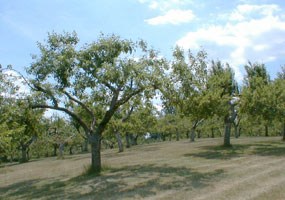
The earliest mention of an apple orchard at Hopewell Furnace dates back to an April 2, 1788 estate advertisement in the Pennsylvania Gazette, which mentions "an excellent young bearing orchard of about 250 apple trees of the best fruit." From the limited evidence available, Hopewell's apple orchard appears to have been typical of the period. Almost all farms had an orchard of several acres to supply the owner's needs. In the early 1800s apples were used at home for cider, apple butter, and dried fruit. They were also used as feed for livestock. The commercial use of apple orchards did not begin until the mid-1800s when improved transportation allowed farmers to ship fresh fruit to the growing cities of New York and Philadelphia. Cultural practices in orchards have changed greatly over time. Historically, in many orchards livestock were allowed to graze among the trees. Hopewell Furnace records of 1858 indicate that potatoes, oats, and corn were planted in the orchard. Although there are several references in furnace records to paying for pruning apple trees, this may have been an infrequent practice rather than the annual chore it is today. Older orchards characteristically had large trees. Modern trees are intentionally dwarfed so that they are easier to manage. Orchard spraying did not become common in Pennsylvania until after 1889. Until that time pest control was limited and losses were high. The National Park Service recognizes the potentially harmful effects of pesticides and strives to reduce or eliminate their use. Hopewell Furnace NHS attempts to control pest and disease damage in the orchard by pruning to allow more rapid drying of trees, timing spraying with the weather and tolerating more fruit damage than a commercial orchard would. A portion of the orchard's crop will show insect damage and/or discoloration from harmless fungus that effects only the appearance of the apples. Hopewell's apples are managed to preserve the historic nature of the orchard in the style of a mid-19th century fruit orchard. Approximately 50 trees were planted in 1942, shortly after the establishment of Hopewell Furnace as a National Historic Site. Another 150 trees trees were planted in 1960. Today, more than 30 familiar and historic varieties are represented. In autumn months visitors are invited to pick their own from the park's orchard and in doing so, can learn their history and eat it too. |
Last updated: February 26, 2015
